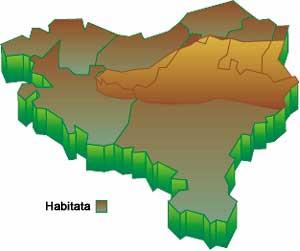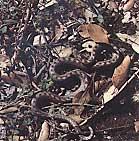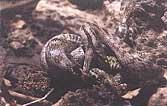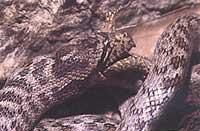Lizard lizards

The soft southern serpent (Coronella girondica) is a small snake that can reach 80 cm, but that normally does not exceed 60 cm. As for the appearance it must be said that it is a slender snake, with a prominent head, dressed in a long tail that constitutes 1/4 of the total length of the body. As for the differential characteristics that we can use to differentiate ourselves from the soft snake of the north (Austrian Coronella) which is its cousin, the rostral scales of the soft snake of the south is wider than the high and has 8 supralabial scales, of which 4 and 5 are in contact with the eye. On the other hand, the dorsal scales along the body have 21 lines (sometimes 19 or 23), usually in the center of the body. Ventral scales are usually between 170-200, while the subcaudals are 43-72 pairs.
The dorsal coloration of the southern soft snake is usually pale brown or silver grey, with a darker brown irregular footprint. The head is also grey, but in it you can appreciate pink hues. Beginning with the prefrontal scales and through the eyes, and stretched towards the neck, it presents in most cases a black footprint or line, representing a singular ornament like the antifaza. Also in the dorsal part of the neck, at the height of the accordion, presents a spectacular dark spot with the shape of V, U or Y, and by extension of its frontal ends can also appear parietal scales and front painted. As for the ventral part of the animal, it may have a reddish, yellowish or weak orange color, which may appear dressed in black spots arranged in a chess mosaic.

The soft southern snake is a western Mediterranean species that lives in Tunisia, Algeria, northern Morocco, Portugal, Spain, Basque Country, Catalonia, southern France and Italy. It is not in Corsica, Sardinia and the Balearic Islands.
Among the European snakes, the soft serpent of the south has been considered ecologically as a guiding species in relation to the xeroteric bioclimatic regions, for being the most characteristic of the termomediterran, mesomediterranas and supramediterranas bioclimatic subregions. In fact, this reptile always looks for dry, rocky and sunny environments, so we find it in arid Mediterranean habitats, Mediterranean, and in luminous forests of mundane streaks, clearings, stones, walls, bushes, etc.
Although in Euskal Herria it can be found in almost all the territory, its hidden way of life means that we do not have too much data to accurately determine its distribution. However, in the Cantabrian Sea, the soft serpent of the south may appear omnipresent but scarcely on the coast, and is more local as we do it inside the earth, not always in wet areas, but in rocky and sunny areas. In any case, it does not appear in the mountainous regions, in the vicinity of the Pyrenees, or in most of the mountains that make up the distribution line of the waters, always below the 800 m of altitude in our territory. In the Mediterranean region, on the contrary, we can say that it can be seen anywhere, although the most abundant is in the most arid areas of southern Alava and Navarre.

As for its way of life, the soft serpent of the south is above all a terrestrial and velvety snake, which is located in places of great sunshine during the day. As has already been mentioned, this snake has a hidden life, seeking its food often in rock sections and slits. As hunters, lizards are the most common prey of the southern soft snake, but occasionally they can be corner, small snakes, some micromamago (Apodemus, Pitymis...), and can also capture insects. And some authors consider that adult specimens may also have a tendency to cannibalism if younger specimens are found.
On the other hand, most of the small predators are at the same time prey, as is the case of the soft serpent of the south, in which you can hunt and eat several snakes (Elaphe, Vipera...), raptor birds (Buteo, Circaetus, Hieraetus...) and mammals (Its scrofa..).
In front of other snakes it is said that it is a slow and relatively slow species, mediocre swimmer, and a subtle pairing (in semi-broken stone walls and inclined trunks of rough bark). He has been joined by a timid and fugitive character, and although some authors have written that he has no aggressiveness, others have opined completely contrary. As for the specimens observed by the author of this article, it should be noted that these were quite aggressive. In any case, the soft snake bite does not pose any danger, since being a snake so small and without appreciable tabs, its bite hardly pierces the human skin and, as happens with most of the species of our country, the smooth snakes are not poisonous either.
The aggression of the soft southern snake is greater towards May. It is at this time that the zeal of this reptile is celebrated. Apparently, and like it happens in other reptiles, this species can be ovíparo or ovíparo depending on the bioclimatic characteristics of the place in which it lives. The laying is usually 4-16 eggs 20-25 x 13-15 mm. Of size, and usually occurs towards July, with ages between 11 and 18 cm. Long, at the end of August or beginning of September.

Smooth snakes, in addition to poison, use other tools to seize, dominate and swallow their hunting pieces. And it is a terrible spectacle the technique of the soft snake in the hunting tasks: nothing more to see the piece, the soft snake attacks him at full speed, bites everywhere and immediately winds the body of the prey with numerous rings. Although the piece is alive, the skillful hunter, without discouraging the “hug” applied to food, seeks himself, with the intention of dwelling in him and begin to swallow the futile. After biting the end of the gaja hunt, the process is usually quite fast and the snake, thanks to its elastic epidermi and its system of free jaws, will take a few minutes to reach a lizard of thickness equal or greater than it. Happy!
TECHNICAL DATA SHEET Culebra south soft Species: Coronella gironFamily: colubriosOrder: squadrosClass: reptiles |
Buletina
Bidali zure helbide elektronikoa eta jaso asteroko buletina zure sarrera-ontzian











